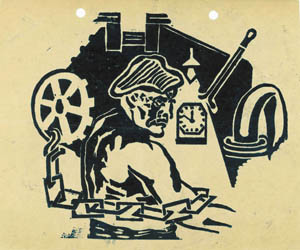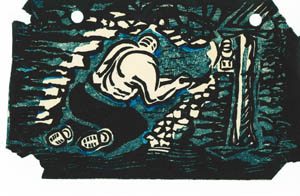Perspectives: Robson Green and the Pitmen Painters, ITV1 | reviews, news & interviews
Perspectives: Robson Green and the Pitmen Painters, ITV1
Perspectives: Robson Green and the Pitmen Painters, ITV1
Miner's son revisits Ashington's colliery artists
The story of the Pitmen Painters, a group of Northumbrian miners who decided to study art appreciation in their spare time and developed into a group of untrained but powerfully expressive artists, has been documented in a book by William Feaver and a play by Lee Hall. Robson Green's particular interest in the story stems from the fact that he's a miner's son, brought up in Dudley, a few miles south of the pitmen's hometown of Ashington.
Green may be a successful actor, but he's no art critic - "I would actually think, why is he showing us this?" he said, confronted with a slide of Michelangelo's The Last Judgement - but he used the story to reflect on his own past, and to look at the tornado of social change that has swirled through the old mining villages since the Pitmen embarked on their art adventure in 1934. Where there used to be networks of communities steeped in the mining tradition (coal mining began on Tyneside in the 13th century), now there aren't any miners at all in Northumberland.
Green's father died in 2009, and had been adamant that neither Robson nor his brother David should go down the pits. Robson made his first and probably last trip down a mine for this film, though he had to travel to Maltby in south Yorkshire to find one still operating. The Painters' work pungently documented the harsh and primitive conditions the miners of yore had become inured to, but Green was startled to discover that in contemporary coal-mining they use powerful industrial cutting machines instead of picks and shovels, and that the tunnels are large enough to stand up in. They seem to have done away with canaries and Davy lamps, too.
 But even with high-speed lifts and a people-carrying conveyor belt it took a couple of hours to get from the surface to the coal face, and Green found the subterranean world hot and oppressive, as well as full of scary noises. All the more remarkable, then, that the Pitmen Painters had had the capacity and the will to come home from a punishing shift underground under far worse conditions, change into a jacket and tie (as somebody said, "leisurewear hadn't been invented"), and go down to their hut in Ashington and apply themselves to painting.
But even with high-speed lifts and a people-carrying conveyor belt it took a couple of hours to get from the surface to the coal face, and Green found the subterranean world hot and oppressive, as well as full of scary noises. All the more remarkable, then, that the Pitmen Painters had had the capacity and the will to come home from a punishing shift underground under far worse conditions, change into a jacket and tie (as somebody said, "leisurewear hadn't been invented"), and go down to their hut in Ashington and apply themselves to painting.
As Green put it, they were driven by "the hunger for self-improvement", a quality no longer detectable in what remains of their old communities today. More than that, they developed a collective spirit in which art was considered a gift to be shared, not a commodity to be traded for money. Considering that these were men who had left school at the age of 12 to go straight down the pit, and had never known a life outside Ashington, it suggested something deep and almost mystical about the nature of art and creativity (works by the Pitmen Painters, pictured above and below).
 Under the benign eye of William Feaver, Green plucked up the courage to have a go at a bit of art himself. His first effort was a hand holding a milk bottle, though he confessed wryly that he'd modelled it using a bottle of Balsamic vinegar, "which I think sums up my life". Prompted by Feaver to try something with a father-and-son theme, his second attempt was a depiction of himself reaching up for freedom while standing on the back of his father toiling down the mines. It wasn't very good, and Green's hesitancy about showing it to anybody was wince-evoking, but his difficulty in expressing himself was another way of measuring the achievements of the old pitmen.
Under the benign eye of William Feaver, Green plucked up the courage to have a go at a bit of art himself. His first effort was a hand holding a milk bottle, though he confessed wryly that he'd modelled it using a bottle of Balsamic vinegar, "which I think sums up my life". Prompted by Feaver to try something with a father-and-son theme, his second attempt was a depiction of himself reaching up for freedom while standing on the back of his father toiling down the mines. It wasn't very good, and Green's hesitancy about showing it to anybody was wince-evoking, but his difficulty in expressing himself was another way of measuring the achievements of the old pitmen.
- Watch Perspectives on ITV Player
-
 Find Robson Green on Amazon
Find Robson Green on Amazon
Share this article
Add comment
more TV
 Blue Lights Series 2, BBC One review - still our best cop show despite a slacker structure
The engaging Belfast cops are less tightly focused this time around
Blue Lights Series 2, BBC One review - still our best cop show despite a slacker structure
The engaging Belfast cops are less tightly focused this time around
 Baby Reindeer, Netflix review - a misery memoir disturbingly presented
Richard Gadd's double traumas are a difficult watch but ultimately inspiring
Baby Reindeer, Netflix review - a misery memoir disturbingly presented
Richard Gadd's double traumas are a difficult watch but ultimately inspiring
 Anthracite, Netflix review - murderous mysteries in the French Alps
Who can unravel the ghastly secrets of the town of Lévionna?
Anthracite, Netflix review - murderous mysteries in the French Alps
Who can unravel the ghastly secrets of the town of Lévionna?
 Ripley, Netflix review - Highsmith's horribly fascinating sociopath adrift in a sea of noir
Its black and white cinematography is striking, but eventually wearying
Ripley, Netflix review - Highsmith's horribly fascinating sociopath adrift in a sea of noir
Its black and white cinematography is striking, but eventually wearying
 Scoop, Netflix review - revisiting a Right Royal nightmare
Gripping dramatisation of Newsnight's fateful Prince Andrew interview
Scoop, Netflix review - revisiting a Right Royal nightmare
Gripping dramatisation of Newsnight's fateful Prince Andrew interview
 RuPaul’s Drag Race UK vs the World Season 2, BBC Three review - fun, friendship and big talents
Worthy and lovable winners (no spoilers) as the best stay the course
RuPaul’s Drag Race UK vs the World Season 2, BBC Three review - fun, friendship and big talents
Worthy and lovable winners (no spoilers) as the best stay the course
 This Town, BBC One review - lurid melodrama in Eighties Brummieland
Steven Knight revisits his Midlands roots, with implausible consequences
This Town, BBC One review - lurid melodrama in Eighties Brummieland
Steven Knight revisits his Midlands roots, with implausible consequences
 Passenger, ITV review - who are they trying to kid?
Andrew Buchan's screenwriting debut leads us nowhere
Passenger, ITV review - who are they trying to kid?
Andrew Buchan's screenwriting debut leads us nowhere
 3 Body Problem, Netflix review - life, the universe and everything (and a bit more)
Mind-blowing adaptation of Liu Cixin's novel from the makers of 'Game of Thrones'
3 Body Problem, Netflix review - life, the universe and everything (and a bit more)
Mind-blowing adaptation of Liu Cixin's novel from the makers of 'Game of Thrones'
 Manhunt, Apple TV+ review - all the President's men
Tobias Menzies and Anthony Boyle go head to head in historical crime drama
Manhunt, Apple TV+ review - all the President's men
Tobias Menzies and Anthony Boyle go head to head in historical crime drama
 The Gentlemen, Netflix review - Guy Ritchie's further adventures in Geezerworld
Riotous assembly of toffs, gangsters, travellers, rogues and misfits
The Gentlemen, Netflix review - Guy Ritchie's further adventures in Geezerworld
Riotous assembly of toffs, gangsters, travellers, rogues and misfits
 Oscars 2024: politics aplenty but few surprises as 'Oppenheimer' dominates
Christopher Nolan biopic wins big in a ceremony defined by a pink-clad Ryan Gosling and Donald Trump seeing red
Oscars 2024: politics aplenty but few surprises as 'Oppenheimer' dominates
Christopher Nolan biopic wins big in a ceremony defined by a pink-clad Ryan Gosling and Donald Trump seeing red

Comments
...